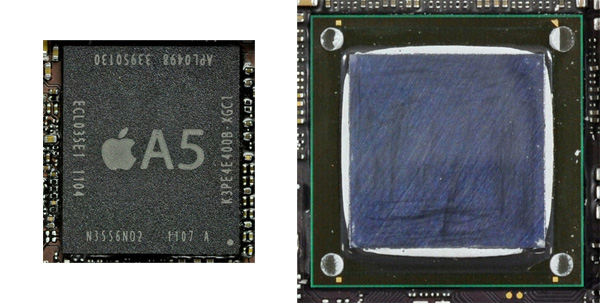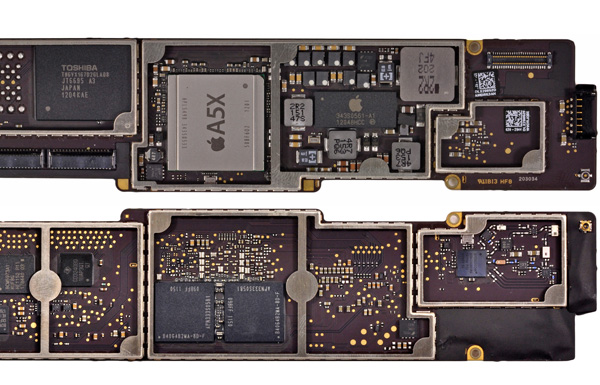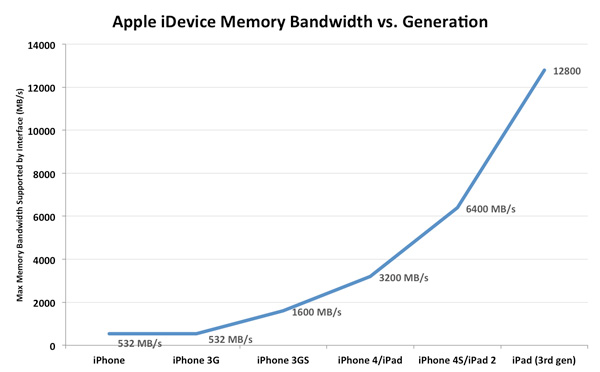The Apple iPad Review (2012)
by Vivek Gowri & Anand Lal Shimpi on March 28, 2012 3:14 PM ESTA Word on Packaging
Unlike the first two iPads, the 3rd generation iPad abandons the high density flip-chip PoP SoC/DRAM stack and uses a discrete, flip-chip BGA package for the SoC and two discrete BGA packages for the DRAMs.
If you think of SoC silicon as a stack, the lowest layer is where you'll find the actual transistor logic, while the layers of metal above it connect everything together. In the old days, the silicon stack would sit just as I've described it—logic at the bottom, metal layers on top. Pads around the perimeter of the top of the silicon would connect to very thin wires, that would then route to the package substrate and eventually out to balls or pins on the underside of the package. These wire bonded packages, as they were called, had lower limits of how many pins you could have connecting to your chip.
There are also cooling concerns. In a traditional wire bonded package, your cooling solution ultimately rests on a piece of your packaging substrate. The actual silicon itself isn't exposed.
As its name implies, a flip-chip package is literally the inverse of this. Instead of the metal layers being at the top of the stack, before packaging the silicon is inverted and the metal layers are at the bottom of the stack. Solder bumps at the top of the silicon stack (now flipped and at the bottom) connect the topmost metal layer to the package itself. Since we're dealing with solder bumps on the silicon itself rather than wires routed to the edge of the silicon, there's much more surface area for signals to get in/out of the silicon.
Since the chip is flipped, the active logic is now exposed in a flip-chip package and the hottest part of the silicon can be directly attached to a cooling solution.

An example of a PoP stack
To save on PCB real estate however, many SoC vendors would take a flip-chip SoC and stack DRAM on top of it in a package-on-package (PoP) configuration. Ultimately this re-introduces many of the problems from older packaging techniques—mainly it becomes difficult to have super wide memory interfaces as your ball-out for the PoP stack is limited to the area around your die, and cooling is a concern once more. For low power, low bandwidth mobile SoCs this hasn't really been a problem, which is why we see PoP stacks deployed all over the place.
Take a look at the A5, a traditional FC-BGA SoC with PoP DRAM vs. the A5X (this isn't to scale):

Images courtesy iFixit
The A5X in this case is a FC-BGA SoC but without any DRAM stacked on top of it. The A5X is instead covered in a thermally conductive paste and then with a metallic heatspreader to conduct heat away from the SoC and protect the silicon.
Given the size and complexity of the A5X SoC, it's no surprise that Apple didn't want to insulate the silicon with a stack of DRAM on top of it. In typical package-on-package stacks, you'd see solder bumps around the silicon, on the package itself, that a separate DRAM package would adhere to. Instead of building up a PoP stack here, Apple simply located its two 64-bit DRAM devices on the opposite side of the iPad's logic board and routed the four 32-bit LP-DDR2 memory channels through the PCB layers.

iPad (3rd gen) logic board back (top) and front (bottom), courtesy iFixit
If I'm seeing this correctly, it looks like the DRAM devices are shifted lower than the center point of the A5X. Routing high speed parallel interfaces isn't easy and getting the DRAM as close to the memory controller as possible makes a lot of sense. For years motherboard manufacturers and chipset vendors alike complained about the difficulties of routing a high-speed, 128-bit parallel DRAM interface on a (huge, by comparison) ATX motherboard. What Apple and its partners have achieved here is impressive when you consider that this type of interface only made it to PCs within the past decade.
Looking Forward: 12.8GB/s, the Magical Number
The DRAM speeds in the new iPad haven't changed. The -8D in the Elpida DRAM string tells us this memory is rated at the same 800MHz datarate as what's used in the iPhone 4S and iPad 2. With twice the number of channels to transfer data over however, the total available bandwidth (at least to the GPU) doubles. I brought back the graph I made for our iPhone 4S review to show just how things have improved:
The A5X's memory interface is capable of sending/receiving data at up to 12.8GB/s. While this is still no where near the 100GB/s+ we need for desktop quality graphics at Retina Display resolutions, it's absolutely insane for a mobile SoC. Bandwidth utilization is another story entirely—we have no idea how good Apple's memory controller is (it is designed in-house), but there's 4x the theoretical bandwidth available to the A5X as there is to NVIDIA's Tegra 3.
There's a ton of memory bandwidth here, but Apple got to this point by building a huge, very power hungry SoC. Too power hungry for use in a smartphone. As I mentioned at the start of this article, the SoC alone in the new iPad can consume more power than the entire iPhone 4S (e.g. A5X running Infinity Blade 2 vs. iPhone 4S loading a web page):
| Power Consumption Comparison | ||||
| Apple A5X (SoC + mem interface) | Apple iPhone 4S (entire device) | |||
| Estimated Power Consumption | 2.6W—Infinity Blade 2 | 1.6W—Web Page Loading | ||
There's no question that we need this much (and more) memory bandwidth, but the A5X's route to delivering it is too costly from a standpoint of power. There is a solution to this problem however: Wide IO DRAM.
Instead of using wires to connect DRAM to solder balls on a package that's then stacked on top of your SoC package, Wide IO DRAM uses through-silicon-vias (TSVs) to connect a DRAM die directly to the SoC die. It's an even more costly packaging technique, but the benefits are huge.

Just as we saw in our discussion of flip-chip vs. wire bonded packages, conventional PoP solutions have limits to how many IO pins you can have in the stack. If you can use the entire silicon surface for direct IO however, you can build some very wide interfaces. It also turns out that these through silicon interfaces are extremely power efficient.
The first Wide IO DRAM spec calls for a 512-bit, 200MHz SDR (single data rate) interface delivering an aggregate of 12.8GB/s of bandwidth. The bandwidth comes at much lower power consumption, while delivering all of the integration benefits of a traditional PoP stack. There are still cooling concerns, but for lower wattage chips they are less worrisome.
Intel originally predicted that by 2015 we'd see 3D die stacking using through-silicon-vias. Qualcomm's roadmaps project usage of TSVs by 2015 as well. The iPhone won't need this much bandwidth in its next generation thanks to a lower resolution display, but when the time comes, there will be a much lower power solution available thanks to Wide IO DRAM.
Oh and 2015 appears to be a very conservative estimate. I'm expecting to see the first Wide IO memory controllers implemented long before then...











234 Comments
View All Comments
mr_ripley - Friday, March 30, 2012 - link
It's a shame some people argue that against the workers when over a hundred of them have committed suicide over the working conditions. How can you still say that they are being offers a better deal here??On the other hand, it is also unfair that Apple is being singled out here. The world of Chinese manufacturing is a dirty one and all major corporations have a part in it. I'd trust Apple over most other companies to make a difference in that regard, and I'm happy to see something is being done in that regard. Ever heard McDonalds CEO touring the slaughterhouse of the meat packing companies??
name99 - Friday, March 30, 2012 - link
Reporting suicides as a number not as a rate shows you to be either a fool or a deliberate liar. How many people, over how many years, comprise the pool from which this suicide number is drawn? Everything I have read says that the actual suicide rate is not only lower than the average rate for China, it is lower than the average rate for the US.mr_ripley - Friday, March 30, 2012 - link
In 2010, 18 workers attempted sucide, 14 succeeded. To me even one in a whole year is not acceptable. If you think that is ok I hope that statistic turns out to be you!!name99 - Saturday, March 31, 2012 - link
The argument was NOT that suicide is a tragedy, it was a claim that FoxConn employees specifically tied to Apple production have such lousy lives that they commit suicide in higher numbers that other people around the world.You have done NOTHING to prove this claim; all you have done is bring up a very different issue.
mr_ripley - Saturday, March 31, 2012 - link
There is no disputing the fact that these deths are related to working conditions. I'm pretty sure this has been well established and documented. However, I did say in my previous post that Apple is unfairly singled out. It could have been any other company.Comparison between suicide rates is irrelevant. Higher sucide rates elsewhere does not justify this problem. Again the fact remains that many people have died and it is directly related to the working conditions.
Apple happens to be in a position to directly influence their lives and make it better, after all they profit in billions from the work these people do. Corporations typically place little value over human life and living conditions (IBM sold equipment to the Nazis to track the Jews in concentration camps). Somehow, I feel Apple is different.
doobydoo - Sunday, April 1, 2012 - link
Dude, sorry but you're talking no sense at all.First of all, pretty much any product you want to buy, electronics wise, uses parts from China where conditions are far worse on average, than Apples factories. So if you actually factored working conditions into the product review, it would look favourable for Apple.
Secondly, your argument that comparison between suicide rates is irrelevant, is absurd. Higher suicide rates where legislation is such that no jobs suffer such terrible conditions that suicide is the only option, such as is the case here, prove that even if working conditions are refined, you still get some depressed people. Your argument, therefore, is with the people who committed suicide. You say it is 'directly related to the working conditions' but where have you evidenced this, at all? You simply haven't. The fact that the suicide rates at Apple factories are lower than some American ones further backs up my point on this.
Every company is in a position to change lives and make them better. You too, are in a position to do this. But guess what. You, just like companies, can do WHATEVER YOU LIKE with your OWN MONEY and have NO OBLIGATION WHATSOEVER to solve the worlds problems. Apple already has amongst the best conditions of factories in China. The amount of profit they make is absolutely irrelevant, if you say Apple should be putting money into this then a lot more manufacturers should also put a lot more money into this. It's very easy to decide what other people 'should' do with their money now, isn't it?
Corporations don't have to adhere to moral values - they are not people. They are there solely to make money. Nothing else. Don't confuse them with people. And I hope you donate every single spare penny to charity and spend every spare second of your time working to build homes in the 3rd world. Oh wait, you're on here crying that other people should do it instead.
Get a hold of yourself you illogical fool.
mr_ripley - Sunday, April 1, 2012 - link
Like I have said before it is a shame some people argue with great zeal against others who are suffering and devalue human life. Fortunately, Tim Cook is not one of them.If scores of people killing themselves citing poor working conditions is not enough proof what is? If your claim that there are work environments in America that have higher suicide rates because of working conditions is true that needs to be investigated as well and rectified.
You give charity to people who are in need and cannot earn for themselves. If you think giving someone fair amount of compensation for hard work is charity you are delusional.
If working in those factories is such a pleasent experience I suggest you try it out for yourself. Maybe the experience might broaden your perspective.
Although, I don't see the point I will attempt to educate you. Legally, a corporation is considered as a person, that is right just like a live human being. Regardless of that corporations are run by people and actions of a corporation reflect upon the morality of the people running them.
I will stop here as there is no point in continuing but you can respond with more insults and accusations of what I do or have done which frankly is no concern of yours.
PeteH - Monday, April 2, 2012 - link
I've not seen a single report of people killing themselves and citing "poor working conditions" as the reason. Can you provide a link?There have been reports of people killed because of unsafe working conditions, but that's a different issue. Maybe you're confusing the two.
mr_ripley - Tuesday, April 3, 2012 - link
Here's a Wikipedia link: you can read some of the circumstances and judge for yourself.They may not have said it in so many words but it is clear they were unhappy with ther work environment.
Imagine your boss coming and beating you up because you lost an iPhone prototype!!!
mr_ripley - Tuesday, April 3, 2012 - link
http://en.wikipedia.org/wiki/Foxconn_suicides